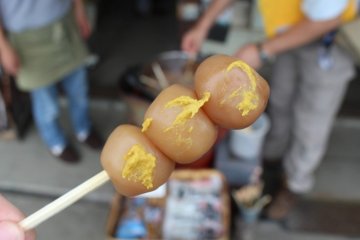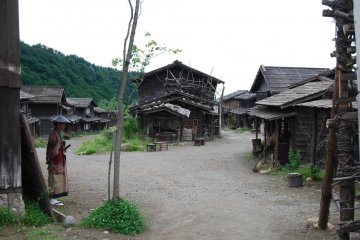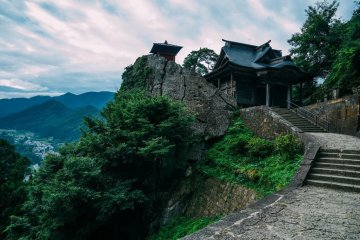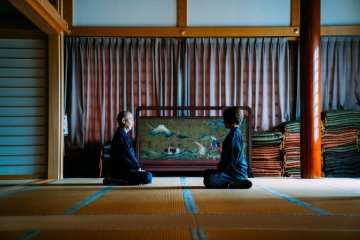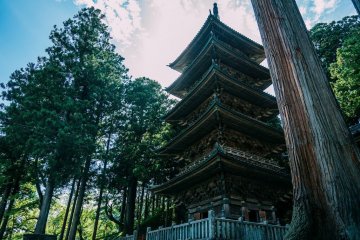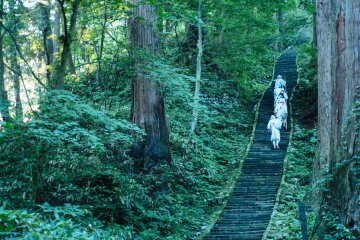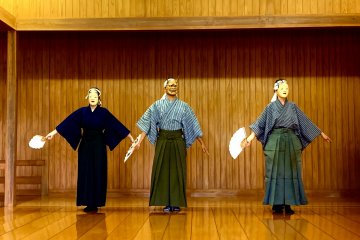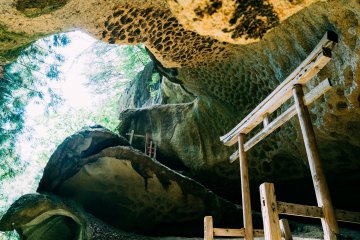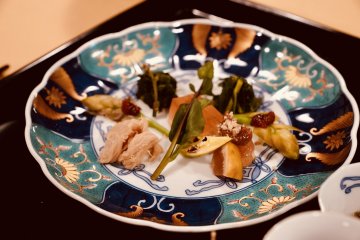As you arrive at Shonai Airport in Yamagata Prefecture you quickly realize that if you're arriving from a major Japanese urban hub, things are very different here. The landscape of mountains, rivers and rice fields are ingrained in the very nature of the people and culture of Yamagata. The relationship with the environment, history and centuries-old traditions are palpable and tangible and seen in the cobbled paths, cuisine and conversations. It's a beautiful and peaceful area of Japan that richly deserves to be experienced.
Day 1
Kurokawa Noh Experience
In Kurokawa, a small village in the Tsuruoka in Yamagata Prefecture, noh theatre is ingrained in the locals who have been performing its own, very distinct, style of noh for hundreds of years with generations of men being handed over the mantle from their ancestors. This is very much 'living noh,' with nearly everyone in Kurokawa being involved in the artform in some capacity.
In February every year, the people of Kurokawa hold a two-day noh festival (Ogi Sai) with the two noh groups of the village, Kami-za and Shimo-za, performing noh productions all through the night in front of village people, guests and their peers. So special is Kurokawa noh that in 1976 it was declared an Intangible Cultural Asset by the Japanese government. Connected with a rich and long history with the local Kasuga Shrine, it's said that noh in Kurokawa was started to help support the shrine.
As visitors to Tsuruoka and the magical and intimate village of Kurokawa, you are allowed a special glimpse into the world of Kurokawa noh by training with the performers and understanding more about the importance of the costumes, masks and etiquette. Participants, in addition to working closely with the local performers, have the chance to observe the masters at work. After watching an engrossing and intimate performance in Kasuga Shrine's theatre, participants in this tour are accompanied over to a practice stage in the Denshukan building where they are mentored in some of the traditional techniques and movements central to Kurokawa noh. You are also dressed in the traditional costumes by experts and it's a real privilege to wear these shozoku or robes along with the ornate and incredibly powerful noh masks and fans.
For lunch, participants are then treated to a unique tofu-based cuisine central to this area of Yamagata. First up and most important is shimodofu or frozen tofu which uses more soybeans than orthodox tofu which makes it firmer, then it's frozen and skewered and finally grilled. In Kurokawa the rivalry between the two groups, Kamiza and Shimoza, even extends to food with Shimoza (which you can experience in this particular program) serving cold shimodofu in a hot broth flavored with soy sauce, sake and sansho (Japanese pepper). Other dishes on offer include kiriae which is made with mountain vegetables, walnuts and green soybeans marinated in soy sauce, seasonal local fruits and vegetables and delicious tsuyahime rice. Local food guide, Kaoru Akiyama, will introduce you to this profound culinary culture in Kurokawa village during lunch.
Bedda Sicilia
After a few hours of learning about and practicing noh theatre it's almost certain you'll be in much need of some sustenance. Bedda Sicilia is on hand to take care of that matter for you with lashings of flavor and style. Owned by chef Koji Furukado, Bedda Sicilia is a startling and very impressive homage to Sicilian cuisine made with local ingredients sourced from the Shonai Tsuruoka region of Yamagata Prefecture. With a focus on vegetables, Furukado weaves his magic throughout every dish and has honed his ample skills at top-end Italian restaurants in Tokyo such as La Benzinai in Nishi-Azabu as well as serving three years training in Italy. Having first visited Italy when he was 26 he plied his trade in Sicily on the island of Ischia in a family-owned restaurant acquainted himself with the intricacies of this kind of Sicilian cooking.
Furukado moved to the Shonai area of Yamagata Prefecture due to a relationship and began nurturing very close ties with the community and with local farmers and producers with the decision to open Bedda Sicilia coming in 2016. It's had a profound effect on the local community as well as other visitors coming from further afield to sample some of his Italian food cooked with the freshness and quality of local Shonai ingredients. It's a charming and stylish location and one which you don't necessarily expect to find in rural Japan. Furukado and his small army of staff make the trip to Bedda Sicilia worth it and you'll leave with the thought of when your next trip there will be.
Daishinbo Lodge
Before heading to the mountains (on day 2) it's a good idea to get a good night's rest. And not far from Mount Haguro is the perfect spot to stay for the night. The 350-year-old temple inn Shukubo Daishinbo offers a traditional Japanese-style stay with a large public bath and most modern convenience. It also hosts a charming Japanese garden, parking facilities and lush nature. It's also a place of prayer and guests can observe Buddhist prayers and ceremonies while staying there. With large and comfortable rooms available it's a lovely spot to rest before the following day of trekking one of the area's most revered mountains, a holy and sacred location which has been worshipped for centuries. Shukubo pilgrim lodges such as Daishinbo are purpose-built accommodation for those making a pilgrimage to the Dewa Sanzan area of Yamagata.
Staying at Daishinbo is an apt and fitting start to your journey in Yamagata and sets the scene for the days ahead.
Day 2
Yamabushi Guided Walk of Mount Haguro

As you approach Mount Haguro, you enter through a huge red torii gate which can be seen for miles around. As you enter through this sacred symbol, you feel a marked lull, a moment of transcendence and a tangible alteration in atmosphere and surroundings. One of the most special elements of this tour is being led by the renowned yamabushi or ancient mountain priests of Japan. Traditionally their role was to assist people in finding their innate nature and of teaching discipline and the ways of warriors. Nowadays the yamabushi lead and navigate visitors through these sacred mountains and lead by example. Humility, silence and introspection are learned here and by observing the yamabushi and their actions we learn about ourselves and our nature, something which is more vital than ever in the current global climate.
Before the trek, there is a special ceremony undertaken with the yamabushi who present you with the sacred white robe which they have been wearing for centuries. With a slightly odd white ensemble and headgear the yamabushi lead with their trekking sticks as ascending Mount Haguro isn't for the faint hearted. 2,446 stone steps await you and in inclement weather this can be tough going. With the expert guidance of the yamabushi, however, and intermittent stops for a breather and a much-needed drink, it's not particularly hard going and can be navigated and achieved even by amateur trekkers.
As you trek the steps become slightly more steeper and you can see for miles around you, you have a truly profound moment of clarity. An epiphany, if you like. Nothing soothes the soul like being in the center of nature, being surrounded with life at its simplest and most authentic forms. Complement this with the humility and grace of the yamabushi and you have one of the most special and memorable experiences of your lifetime. And what awaits trekkers at the peak of Mount Haguro? Only the stunning Dewa Sanzan Shrine replete with one of the country's thickest thatched roofs. It's a striking scene and a beautiful way to end the trekking section of this tour.
This particular tour involves eating with the monks of the Dewa Sanzan Shrine where attendees are introduced to shojin ryori (a unique vegetarian cuisine, with a 1,400 year history) from this region of Yamagata.
Onsen and Stay at Tsukasaya
After a long day trekking most visitors to this part of Yamagata are in much need of a bath and a good night's sleep. The quaint and extremely comfortable Tsukasaya ryokan in the legendary Yutagawa Onsen area is really recommended. Owned by Takehiko Shoji, the inn has been in his family for 10 generations. Shoji is also a very talented chef and has represented the Shonai area at cooking competitions and exhibitions in Italy. He is also a sake expert so you know that the cuisine and drinks on offer at Tsukasaya will be top notch.
With a focus on vegetarian dishes, Shoji and his wife learned a lot about the hospitality industry from their time spent working at famed Japanese luxury hotel group Hoshinoya. Having studied hotel tourism at Hoshinoya, they returned to Shonai Tsuruoka and took up Shoji's family business. With spacious and warm rooms, baths and all modern amenities, Tsukasaya is the perfect location for a rest, warm and delicious local food and a look into centuries-old culture and tradition. Not far from Tsukasaya, in Tsuruoka, is Suiden Terrase Hotel which has great views of mountains and rice terraces and has a plethora of hot springs and great local food on offer for guests.
Day 3
Zenpoji Temple
The incredible Zempoji Temple, which was built in 938, is located not far from the sea and local fishing port which makes Zempoji special to the thousands of fishermen who pray here each year in the hope that the deities protect them and give them bountiful harvests. Zempoji is home to one of Tsuruoka's two five-storey pagodas (the other is to be found on Mount Haguro). The large temple complex is stunning and, deservedly so, attracts visitors from near and far who marvel at the temple's beauty and almost tangible serenity.
Zempoji Temple is founded and focused on the practice of Zen Buddhism and there are apprentice monks who train there in the hope of, ultimately, becoming Zen masters. Clad in resplendent, yet humble robes, the apprentices participate in routine work such as sweeping the floors and cleaning the temple which is actually considered part of Zen training and the spiritual ethos behind it. Eating and meditation is also considered part of training and these two components are available for visitors who would like to participate in meditation and experience shojin ryori (traditional vegetarian cuisine of Buddhist monks).
Participants in the meditation session will learn about the zafu (cushion), gasho (putting your hands together to pray) and how clockwise rotation are all vital in this centuries-old practice. The monks also teach you to make the proper body position to meditate (with your eyes open focusing about three meters ahead of you) and about your hand position making a circle with your hands which represents the "heart of Buddha." The monk rings the bell three times to begin the meditation and you are instructed about the concept that you attempt to "not see," disregard any thoughts that enter your mind and to let go. In essence, we try to disengage with everything and try to stop being human as we disregard material desires and the human condition.
After meditation, visitors have the chance to experience shojin ryori with the monks who serve you rice, vegetables and miso soup. It's a simple meal which ends with the bowls and various accoutrements being washed with hot water and slices of pickles which are used to clean. Shojin ryori is the traditional food of monks and they instruct the participants in the practice, regulations, ingredients, etiquette and preparation of this kind of cuisine and we learn why it plays a central role in the training and discipline of the monks at Zenpoji.
Sansai Ryori Dewaya
In this specific tour, participants experience the wilds of Mount Gassan with professional mountain guide and forager Yasuo Shibuya. In his 70s now, Shibuya has been walking these mountains for decades and knows them like the back of his hand. His daily finds usually make their way into the kitchen of the Sato clan's renowned restaurant, Sansai Ryori Dewaya (aka Dewaya). Shibuya explains that due to the heavy snowfall in the area of Nishikawa-machi, where Dewaya is located, the spring water which comes from the melting snow is extremely pure which is why the Sato family and Shibuya refer to Mount Gassan as their "natural refrigerator," where there is an abundance of mushrooms, bear meat and sansai (mountain vegetables). As Shibuya nears retirement, he is passing on his knowledge about the mountains and foraging to the Sato family in the hope that they will keep this age-old tradition alive. Participants will have the opportunity to traverse the mountains with Shibuya and then take their natural bounty back to the kitchen at Dewaya where chef Haruki Sato will cook this feast in front of your very eyes. It's a once-in-a-lifetime opportunity where you can experience the water, air and cuisine of Mount Gassan with all five senses and an experience to be forever cherished.
There are a lot of mushrooms being used at Dewaya. It seems that every possible variety appears on the expansive and multi-course menu. "Arrive hungry" is some of the best advice before coming to this part of Yamagata. With hiratake, tamogitake, tobitake and yamabushitake mushrooms being used in only the first few courses, it sets a precedent for what is about to come. Dried persimmons with cream cheese, rokujotofu (thin strips of tofu mushrooms), yukishitaninjin (snow town carrots) and so much more, Dewaya is a serious destination for serious foodies. Prepare to experience food and textures that you didn't really know existed.
Sato grew up watching his grandfather (a former proprietor of Dewaya) do the cooking, before eventually learning his trade as a chef at a Tokyo restaurant. Haruki is the sole cook with his charming wife Yumi acting as front of house, and younger sister Akina in charge of the kitchen. It's very much a family-oriented business and if you're lucky enough to reserve a seat at the chef's table you can observe Sato cooking literally in front of you. Graceful and quiet, Sato and his wife run a perfect dining room with servers entering and leaving without any fuss. Although Dewaya places emphasis on seasonal local vegetables and fruit, it does use fish and meat (as long as they are in season and caught locally). Ayu (riverfish), duck, wild game (like deer) and even bear meat can be found on the menu.
Day 4
Urayamadera route
For the more adventurous person out there, there is the secret backroad path of the legendary Yamagata-based temple, Yamadera. It's a route known as Omoteyamadera or Urayamadera (the backroad of Yamadera) which is gaining traction on social media due to its status as a "power spot." It's said that the monk who founded Yamadera, Ennin (Jikaku Daishi) who built the complex in 860, meditated in these forests and first thought of the possibility of a temple there. In fact the original Yamadera was originally located in these back paths and woods. This particular route takes you amongst the wilds and forests which cover and grace the mountain which hosts Yamadera. Essentially a backroad, it would be wise to come equipped with hill walking footwear and comfortable clothing as the footpath can be slippy and slightly treacherous in parts. It's essentially an alternative way of viewing Yamadera, away from other tourists and visitors and a route which invites solitude and some introspection.
Monks used to train here and undergo periods of meditation. You will find small caves with small shrines implanted into stone walls and it's worth touching the caves and stone as they are said to have special powers. This backroad also affords some spectacular views of the Yamadera area and surrounding landscapes, so if you have some time in your schedule it's definitely worth trying this backroad and alternative journey through the natural beauty of Yamadera.
The Yamadera area is quite simply one of the most tranquil and beautiful parts of the country and it comes as no surprise that people come from near and far to climb the famous 1,000 steps. It's calm, invites thought and contemplation and is, ostensibly, a physical manifestation of the Zen Buddhist ideal. Yamadera has everything; history, culture, fascinating stories, people, legends, fables and views which you can never forget. It's a place which deserves its reputation as one of the most spectacular sightseeing spots in Japan.
Day 5
Yonezawa
Before heading back on the shinkansen, any trip to Yamagata wouldn't be complete without a trip to Yonezawa. A beautiful and historic part of Yamagata and one bursting with culture and tradition, it's a fitting way to end your trip to this part of Japan. Renowned for being the heartland of the once powerful Uesugi clan, it's historically a castle town which shows its history on its sleeve with pockets of the city displaying its proud culture and profound links to its rich and colorful past.
The beautiful Uesugi Shrine should be on any visitor's schedule. With various nooks and crannies, halls and areas, it's a great place for strolling around and getting a feeling for the area and its connection with the Uesugi clan. One of Yonezawa's most famous sons is former daimyo and major influential figure during the Edo period, Yozan. There are statues and memorials to him dotted throughout the city and even John F. Kennedy was a fan and cited him in various speeches and documents. In fact, Kennedy's daughter and former American ambassador to Japan, Carolyn Kennedy even visited Yonezawa and paid tribute to Yozan and his influence on her father.
Denkoku no mori is a facility which is comprised of the Yamagata Prefecture Okitama Culture Hall and Yonezawa City Uesugi Museum and is a huge space which includes a huge portable noh theatre stage which can be seen when entering the facility's lobby. For history buffs it's an essential stop off and visitors can learn more about the Uesugi family and their influence on Yonezawa and Japan as a whole. It's a fascinating area of Yamagata and has a very different atmosphere from other regions on this trip.








